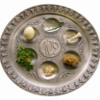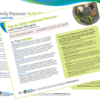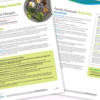Passover is a holiday that is rich with meaning and filled with traditions, many of which involve food. If you are managing food allergies, this list can help you find new ways to keep those traditions while keeping your child with food allergies safe and included.
Fulfilling the Passover Traditions
Consult Your Experts
We understand that in Jewish law, avoiding risk to life is very important. If you have concerns about whether a tradition or food is safe for your child, talk with your allergist. Also, your rabbi may be able to help you find a safe way to adapt a tradition for your family. The Kids With Food Allergies community is a great place to connect with other parents who can share experiences.
Possible Food Substitutions for the Seder Plate
If your child has contact allergies, avoiding allergens at the Seder table may be necessary. Otherwise, you may just need to replace items that contain your child’s food allergens. Here are some ideas:
- Wine/grape juice – Other liquids may be able to be substituted for the “four cups,” such as a juice, water, or formula.
- Matzah – Certified gluten-free oat matzah is available from Lakewood Matzoh. There are also non-grain faux “matzahs," which may work for symbolic purposes only, such as Yehuda Gluten-Free Matzo.
- Roasted shank bone of a lamb – Replace with a red beet, the only vegetable known to “bleed.”
- Roasted/hardboiled egg – Replace with a plastic egg containing seeds that are safe to eat or seeds that your family can plant together after the Seder. Just like the egg, the seeds will represent rebirth and the coming of spring.
- Bitter herbs – Use romaine lettuce, other bitter greens, or horseradish.
- Charoset – Use a nut-free recipe (such as Turkish Charoset from KFA’s Safe Eats™ Allergy-Friendly Recipe Collection). For children who are able to eat only sugar, make a sugar and water syrup. For those who cannot eat at all, mix sand and water into a mortar-like paste to represent the charoset.
- Karpas – Parsley, celery, or potato are traditional options, or you can substitute with another vegetable. For children who can have only sugar, dip sugar candies into the salt water.
Passover Cooking
If your child has egg, nut, wheat, or gluten allergies, cooking for Passover can be a challenge. It is possible to make allergen-free meals that are also kosher for Passover. Just don’t limit yourself to traditional Passover dishes.
Passover recipes: KFA’s SafeEats™ Allergy-Friendly Recipe Collection has almost 1,500 recipes. To find them, enter the keyword “Passover” in the search box. There are also allergy-friendly cookbooks that have Passover recipes. Consider A Taste of Freedom by Tamar Warga and The Kosher Celiac’s Passover Cookbook by Anne Luder.
Allergic to Corn, Soy, Rice, or Beans?
Many kosher for Passover foods do not contain corn, soy, rice, or beans. Passover is a good time to consider stocking up on safe products for the year if your child has any of these allergies. This includes baking ingredients, packaged goods, toothpaste, cleaning detergents, and more. However, be sure to avoid products labeled “for those who eat kitniyot.” As always, check with the manufacturer to make sure a product is safe for your child.
Fun Family Activities for Passover
Arts & Crafts
- Food-free Seder plate – Create a Seder plate out of arts and crafts materials.
- The roasted shank bone of lamb can be made of wood.
- The egg can be wood, plastic, Styrofoam®, or ceramic.
- The bitter herbs can be plastic or silk greenery.
- The charoset can be sand and water mixed together to create a mortar.
- The karpas can be made using green pipe cleaners and salt water.
- The roasted shank bone of lamb can be made of wood.
- Cardboard matzot – Children can make cardboard matzot, pretending to make them in 18 minutes as if they were in a matzah factory. You can also buy cloth or wooden matzot.
- “Wine” bottles – Children can make a special “wine” bottle for their safe drink. Have them choose a beautiful glass bottle from a craft store and decorate it with glass paint.
- Kiddush cups – You can use glass paint to decorate glass wine cups, or use permanent markers to decorate plastic wine glasses.
- Pillow – Create a special pillow for your child to sit on during the Seder. Take plain colored pillow cases and color them with safe markers or puffy paint. Be sure to insert a piece of cardboard into the pillow case to keep the colors from bleeding through while your child is working.
- Matzah Cover – Cut four 9-inch-by-9-inch (or larger) square pieces of solid color cloth or felt. Decorate one square. You can use fabric paint, permanent markers, and/or decorations such as sequins, buttons, bits of ribbon, or yarn. Layer the four squares on top of each other, with the decorated one on top. Stitch around three sides of the square to create a matzah cover with openings for the three matzah used in the Seder.
- Placemats – Have your children decorate large pieces of construction paper to make special Passover placemats. They can illustrate what Passover means to them, their favorite parts of the story, etc. Laminating them can create a keepsake for years to come.
Other Activities for Passover
- Trivia game – Create a fun trivia game for your family and guests. You can Google “Passover trivia game” to find websites that list questions you may want to include.
- Music – Prepare song booklets for the Seder table that contain both traditional Passover songs and fun parodies. Google “Seder song lyrics” or “Passover parody lyrics” for ideas.
- Finger puppets – Make or buy finger puppets, such as of the Ten Plagues or the Four Questions, for your children to use during the Seder. Google “Passover finger puppets” for options.
- Scavenger hunt – Create a scavenger hunt for finding the afikomen. For those who cannot have wheat, you can use an oat or cardboard matzah for the afikomen itself.
- Coloring – Print out Passover coloring pages for your child to color during the Seder. Google “Passover coloring pages” to find pictures to download.
Note: Some of the activities presented many not be Halachically permissible. If you are uncomfortable with any of the ideas, please avoid those activities or consult with your rabbi.
JOIN NOW
Originally published April 2015, updated April 2022




Comments (11)